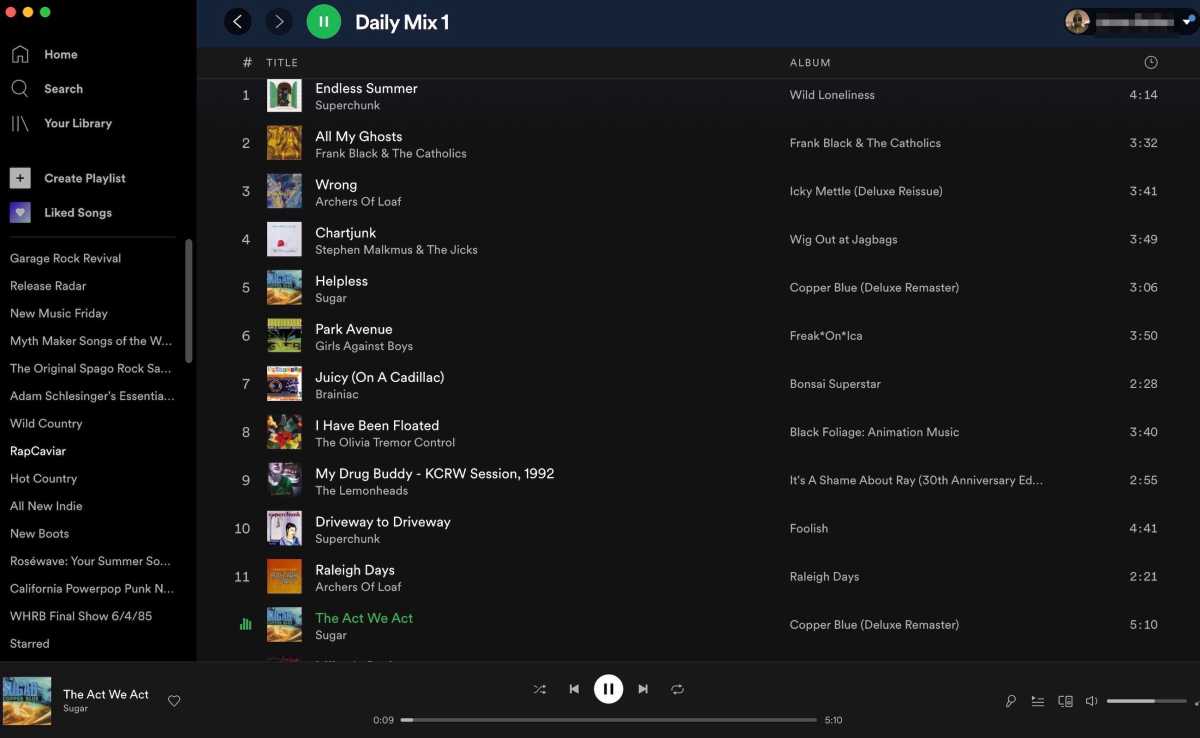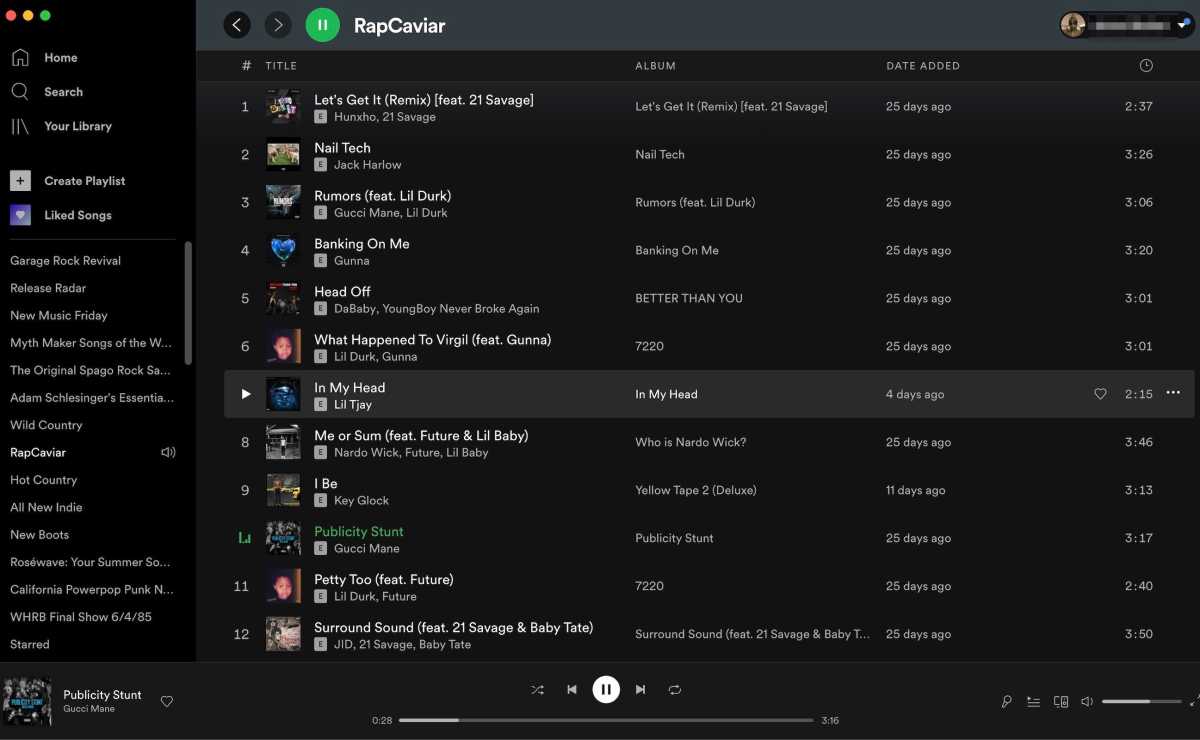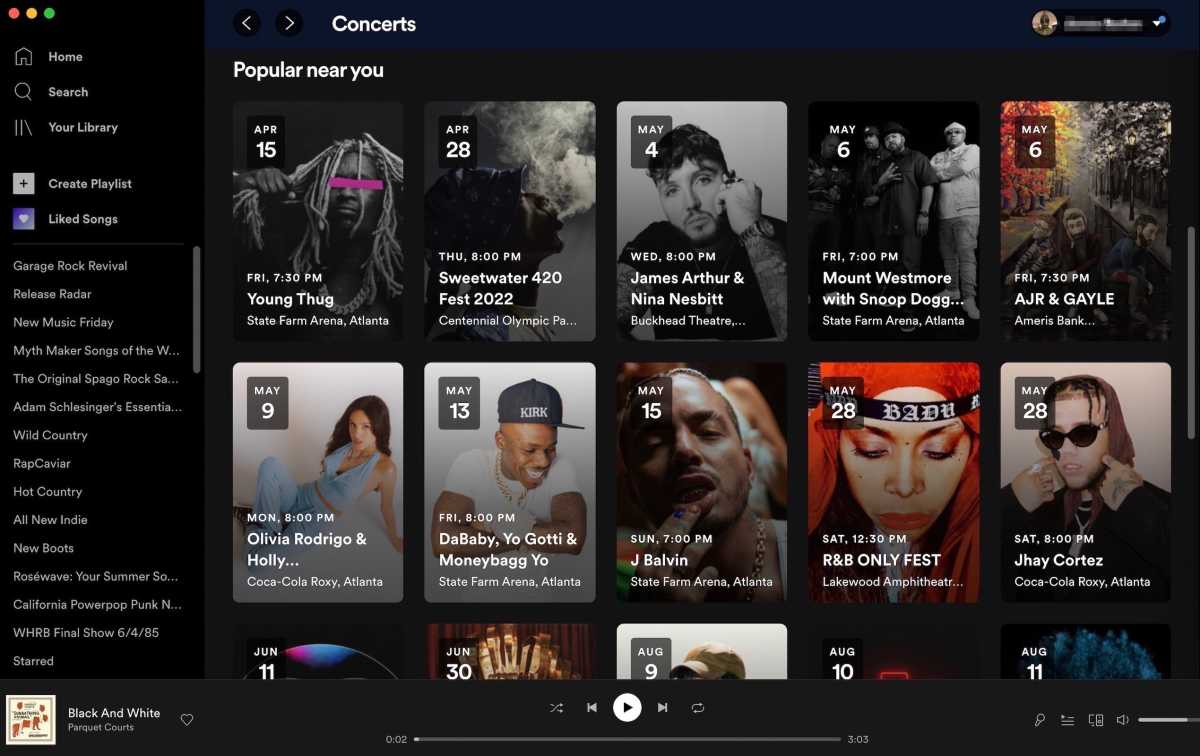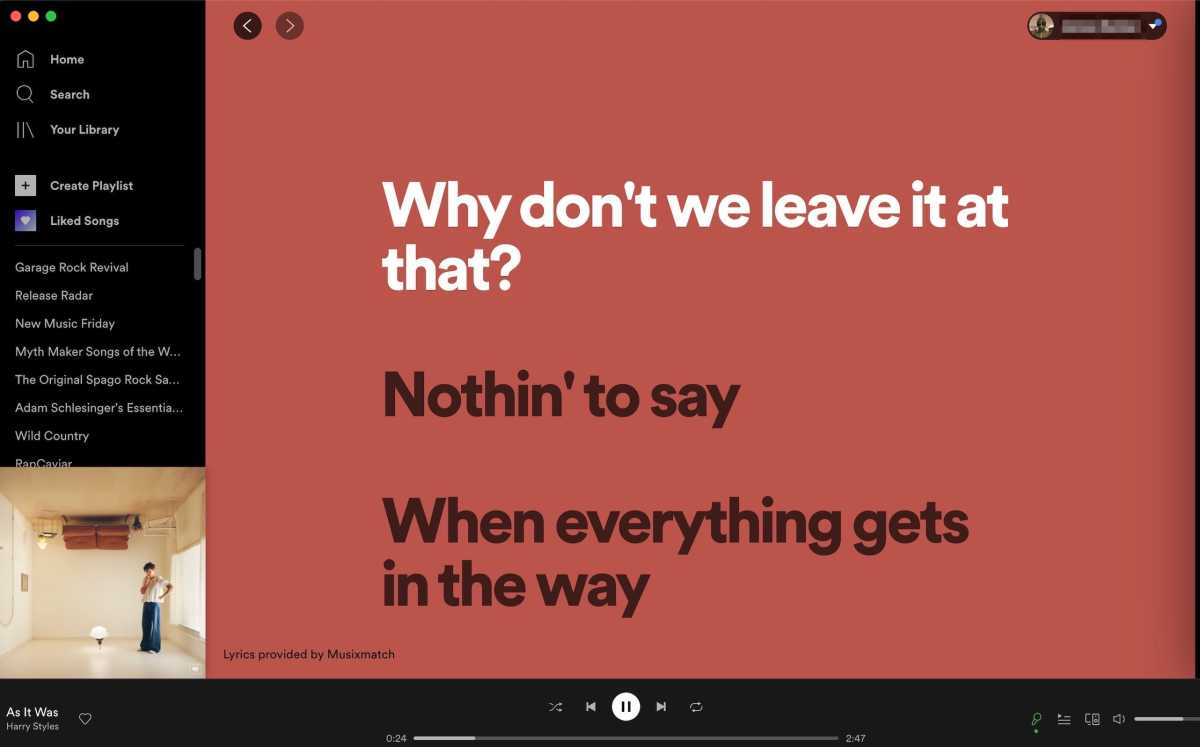At a glance
Expert’s Rating
Pros
- Superior recommendation algorithm
- Offers information about concert dates
- Great for sharing music listening habits with friends
Cons
- Unacceptably low streaming quality
- Now missing some important artist catalogs
- Advertising-based streaming delivers far lower royalty payments to creators
Our Verdict
Spotify’s user-specific playlists are a wonder, but the service is no longer competitive now that the other major players have moved to lossless or better streaming. Spotify needs an update before it gets left behind.
Price When Reviewed
$9.99/mo; Premium Duo plan: $12.99/mo; Family plan: $15.99/mo; Student plan: $4.99/mo
Best Prices Today
Spotify is the world’s largest streaming service if you’re just counting paid subscribers. Add in the massive number of users who take advantage of its free listening tier, and you realize that the company has access to an unfathomable trove of data about how people listen to music.
At its best, Spotify uses that data to fuel a recommendation engine that really has no peer in the streaming business. Unfortunately, the company has failed to keep up with the competition in other critical areas and, until those issues are addressed, you might want to look elsewhere for a music-streaming service.
Because of its listener base, Spotify is the company that most artists and record companies look to first. Its influential new music playlists play a major role in breaking new artists in pop and rap music. Spotify is the only streamer that attempts to list an artist’s tour dates. If you care about the music your friends are playing, the service has the best social sharing tools, and it gives you the option to track what others are playing in real time.
There’s also a lot of ill will from a vocal segment of the creative community. Some don’t like what the free tier does to lower royalty payments, others complain about the streaming quality, and there are questions about the company’s massive investments in areas that have nothing to do with music.
Spotify supports emerging artists by including live show dates and links to merchandise on each performer’s home page.
James Barber/Foundry
Where you come down on the Spotify question has a lot to do with what you’re looking for when you subscribe to a music-streaming service. What are strengths for some users will be deal-breakers for others. Let’s break down the issues so you can decide.
How much does Spotify cost?
Spotify Premium costs $9.99/month. You can add a second person living under the same roof with the Premium Duo plan at $12.99/month. The $15.99/month Premium Family plan supports up to six people (with the same living arrangement restriction), and it comes with an explicit content filter and a Spotify Kids app that exclusively streams children’s music.
Spotify Student costs $4.99/month and comes with free subscriptions to Hulu’s ad-supported tier as well as Showtime. Users who qualify with SheerID are eligible for this subscription for up to four years.
Spotify offers a popular free tier that give access to the entire music catalog, but with significant restrictions. You’ll get ads with your music and, if you want to listen to a particular album, you’ll only be able to play it on shuffle. Free users cannot play individual tracks on demand. Finally, streaming quality on the free tier is limited to just 160Kbps.
Spotify doesn’t offer high-quality streams
If you’re a paid user, Spotify streams music at 320Kbps using the Ogg Vorbis compression format. While not as popular as MP3, Ogg Vorbis has the advantage (for Spotify) of being an open-source, royalty-free technology. While its proponents have long claimed it has better audio quality than MP3, Ogg Vorbis has never really caught on outside of Spotify.
Spotify uses the AAC format at 256Kbps to stream from its web player because of technical issues with streaming Ogg Vorbis from a browser.
And—that’s it. While Tidal, Apple Music, Qobuz, Amazon Music Unlimited, and Deezer have all introduced CD-quality or better streaming, Spotify hasn’t improved its quality in years. Granted, when they introduced the current 320Kbps standard, it was a huge step up in streaming quality. Times have changed and Spotify lags the field (as does YouTube Music Premium, but that service offers a library that’s larger than anyone’s).
Spotify did promise that a new tier called “Spotify HiFi” would be released in 2021. In its February 2021 press release, the company promised a “CD-quality, lossless audio format” and that Spotify Premium users would be offered the option to “upgrade” in “select markets.”

Spotify uses its incredibly deep store of data to create its outstanding Daily Mix playlists.
James Barber/Foundry
Tidal, Apple Music, Qobuz,, and Amazon Music Unlimited all offer high-resolution streaming at bit rates much higher than the lossless CD rates that Spotify promises. Apple and Amazon do it for a monthly price that’s equal to what Spotify charges now, and Tidal’s CD-quality tier also costs the same as Spotify.
If Spotify comes out with an upgraded HiFi tier at $14.99/month, the service will still be playing from behind. If the Premium tier goes CD-quality at $9.99/month and they offer high-resolution options at $14.99, Spotify will have at least some claim to being competitive with the competition.
While there’s a popular notion that “no one can hear the difference” between lossy and lossless audio, there’s a marked disparity between Spotify’s streaming quality and the CD-quality streams from its competition. After a direct comparison between dozens of tracks on the various services, I was surprised at just how much worse Spotify’s streams sounded.
Just to check, I asked six friends and family to pick a favorite song until we landed on one that was CD-quality at Apple Music and Tidal. I then played a minute or so from the song in a blind test between Spotify and the other two. Every single person was able to identify the Spotify stream and thought it sounded worse.
If you test out Spotify for yourself and don’t hear a difference, you can ignore my analysis. But anyone who’s not already deeply embedded in Spotify as a music streamer owes it to themselves to make the comparison.
There are some very good reasons to be deeply embedded in Spotify. The service’s Rap Caviar, Viva Latino, Hot Country, Fresh Finds, and New Music Friday playlists are programmed by humans and are now considered hugely influential bellwethers for rising new artists. I personally know a few dozen music industry players who use Qobuz or Tidal for their personal listening, but subscribe to Spotify because these playlists are so essential to their business.
Even more impressive are the personalized Daily Music mixes, which are algorithmically generated based on your personal listening habits. They combine songs you’re intimately familiar with, with brand-new tracks the algorithm thinks you’ll like and deep tracks from catalog artists you may or may not have heard before. If you listen across multiple genres, you’ll get playlists that focus on what you’re playing. I’ve got six different Daily Music playlists these days, focusing on multiple types of rock, jazz, electronic, and hip hop.

Spotify’s Rap Caviar has a reputation as the most influential music discovery playlist in the world.
James Barber/Foundry
This is exactly where the scale of Spotify makes a crucial difference. Spotify is not only tracking my personal listening habits, it’s cross-referencing my plays with the thousands or millions of other listeners who play the same songs. The playlists are truly great—they might be the best single feature available from any streaming service.
You also get a New Music Weekly playlist that mixes brand-new songs with old stuff Spotify thinks you like and a Release Radar playlist that delivers the latest tunes from artists you follow. If you care about keeping up with what’s new, these playlists are essential.
As Spotify expands its business into spoken-word content, they’ve incorporated news and advice into playlists like Daily Drive and a personalized morning show called The Get Up. It’s all designed to keep you inside the app.
Tracking live shows on Spotify
Spotify is the only streaming service that has tried to crack the notoriously difficult live concert listings. Scraping data from ticketing sites like Ticketmaster, Songkick, Eventbrite, and AXS, it covers an impressive majority of live music shows in the United States and around the world.
You can also generate a listing for shows in your local market. It’s not comprehensive enough to replace your best local concerts site, but it’s a useful tool when you’re trying to keep up with live music in your hometown.
Spotify has also gotten into the merchandise business by partnering with fulfillment company Merchbar. Artists can add a merch section to their page, located at the bottom near their concert listings, to sell t-shirts, hoodies, CDs and vinyl.

Spotify is the only major streaming service that offers information about live shows.
James Barber/Foundry
Lyrics on Spotify
Spotify has partnered with Musixmatch to offer lyrics for many of the songs on the site. What’s really impressive is just how large the lyrics are when they scroll across the screen and how much they pop against a brightly colored solid background. It’s the perfect option for anyone who wants to play karaoke bar with their streaming service.
Spotify’s desktop app and browser experience
Spotify’s desktop app display is very dark, much like the mobile version. The layout is clear and easy to follow, with personalized content emphasized at the top of the page. There’s also a lot of real estate dedicated to podcasts. I’ve never listened to podcasts on Spotify, and I’ll note they’re no longer suggesting I might like Joe Rogan, their most popular podcaster. I can’t decide whether that’s based on my listening (I used to play a lot of Neil Young) or a more general policy decision. Perhaps Joe no longer needs the promotion.
The Mac app has yet to be updated for Apple Silicon, but the designed-for-Intel app performs flawlessly with the Rosetta 2 translator. There’s no rush for a new version. The browser version looks and works the same but, as mentioned above, it streams in a lower resolution and different audio format because of technical issues.
Filtering out the noise on Spotify
Detractors in the creative community believe that Spotify’s free tier makes it too easy for listeners to get their music fix without paying for it. It’s a fact that advertising-based streaming delivers far lower royalty payments to creators. Whether removing a free tier would get any of the free listeners to pay up is an open question, but there’s a strong sense that Spotify could set a few more limits on the free tier to encourage signups.
Lately, the debate has been fueled by Spotify’s attempts to branch out beyond music streaming. Creators who initially resisted putting their songs on the service eventually decided to partner with a site that promised to help save their industry from the file sharing-fueled slump early this century. Labels invested money to keep the young company afloat and artists accepted what they considered low royalty rates in hopes they could contribute to a new industry model.
What everyone declined to notice was that, even with low royalty rates, music streaming is an incredibly low-margin business. Fully 70 percent of income goes out the door to copyright holders before you’ve spent a dime on overhead and salaries.
That’s why podcasting is so attractive to many investors. Costs for content are lower than they are for music licensing, and listeners hooked on exclusive podcasts are reputed to be even more loyal than music fans.

Spotify’s lyrics are huge and easy to read.
James Barber/Foundry
That’s why Spotify paid a rumored $200 million to host the Joe Rogan Experience. Unfortunately, the company has yet to admit that it’s no longer merely a conduit for controversial content like it is with music. As the publisher of podcasts, it’s now responsible for the material it releases.
If you want to listen to Neil Young, Joni Mitchell, Nils Lofgren, Graham Nash, or India Arie, you’ll need to go to another service, because those artists have pulled their music off Spotify over the company’s response to misinformation about COVID aired on Rogan’s show or his history of using racist language on his show.
Another outside investment is the Spotify deal to be the uniform sponsor for the European football powerhouse FC Barcelona, an agreement that’s rumored to pay the team more than $300 million. That’s not a particularly good look for a company that’s taking heat for allegedly exploiting the artists who create the content that made it rich.
Spotify looks at Apple Music, YouTube Music and Amazon Music as the primary threats to its growth. None of those companies are looking to music streaming as the primary engine for financial success, and they might even absorb financial losses on their services because streaming supports their broader business goals.
On the other side, Tidal, Qobuz, and Deezer are music streamers devoted exclusively to music, but none of them has mounted a significant threat to Spotify’s subscriber base. Those services are probably happy to be niche players because they’ve committed themselves to music and seem to have made peace with whatever growth limitations that might entail.
Our bottom line on Spotify
Can Spotify be the best and the worst streaming service at the same time? The service has leveraged the enormous amount of data it has collected and offered a glimpse of just how powerful a recommendation algorithm can be. If it eventually incorporates the kind of musician, engineer, songwriter, and producer data that Tidal uses, Spotify has the potential to revolutionize the way we listen to music.
Unfortunately, not only have they fallen behind when it comes to streaming quality, they’ve kept kicking the can down the road when it comes to revealing exactly what their plans to upgrade might be. As of today, you can have a far better listening experience from the competition. If you’re the kind of person who picks an album or an artist and listens to their music and doesn’t care about the Spotify-generated playlists, it’s time to consider a change.
If Spotify upgrades its audio and offers better quality at a reasonable price, it has the potential to continue its dominance and brush off the controversies that have rocked the company’s image in 2022. In the meantime, many subscribers would be wise to investigate what other services have to offer.

